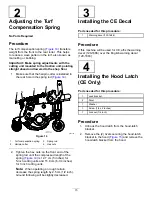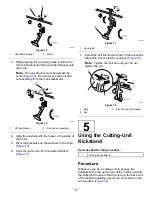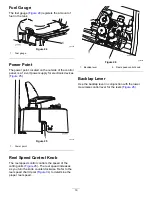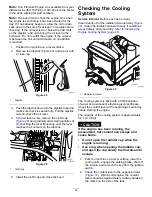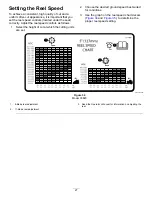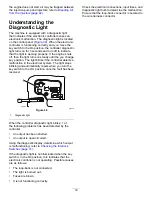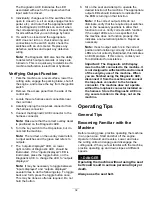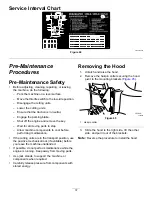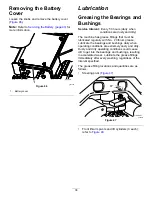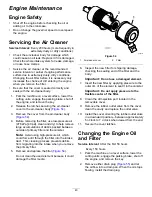
Slope Safety
•
Slopes are a major factor related to loss of control
and rollover accidents, which can result in severe
injury or death. You are responsible for safe slope
operation. Operating the machine on any slope
requires extra caution.
•
Evaluate the site conditions to determine if the
slope is safe for machine operation, including
surveying the site. Always use common sense
and good judgment when performing this survey.
•
Review the slope instructions, listed below, for
operating the machine on slopes. Before you
operate the machine, review the site conditions to
determine whether you can operate the machine
in the conditions on that day and at that site.
Changes in the terrain can result in a change in
slope operation for the machine.
– Avoid starting, stopping, or turning the machine
on slopes. Avoid making sudden changes in
speed or direction. Make turns slowly and
gradually.
– Do not operate a machine under any conditions
where traction, steering, or stability is in
question.
– Remove or mark obstructions such as ditches,
holes, ruts, bumps, rocks, or other hidden
hazards. Tall grass can hide obstructions.
Uneven terrain could overturn the machine.
– Be aware that operating the machine on wet
grass, across slopes, or downhill may cause
the machine to lose traction.
– Use extreme caution when operating
the machine near drop-offs, ditches,
embankments, water hazards, or other
hazards. The machine could suddenly roll over
if a wheel goes over the edge or the edge
caves in. Establish a safety area between the
machine and any hazard.
– Identify hazards at the base of the slope.
If there are hazards, mow the slope with a
pedestrian-controlled machine.
– If possible, keep the cutting units lowered to
the ground while operating on slopes. Raising
the cutting units while operating on slopes can
cause the machine to become unstable.
Starting and Shutting Off
the Engine
You may need to bleed the fuel system if any of the
following situations have occurred; refer to
the Fuel System (page 29)
:
•
Initial startup of a new engine
•
The engine has ceased running due to lack of fuel.
•
Maintenance has been performed upon the fuel
system components.
Starting the Engine
1.
Ensure that the parking brake is engaged and
the cutting unit drive switch is in the D
ISENGAGE
position.
2.
Remove your foot from the traction pedal and
make sure that the pedal is in the
NEUTRAL
position.
3.
Move the throttle lever to the 1/2 throttle position.
4.
Insert the key into the switch and rotate it to
the O
N
/P
REHEAT
position until the glow-plug
indicator light goes out (approximately 7
seconds); then rotate the key to the S
TART
position to engage the starter motor.
Note:
Release the key when the engine starts.
The key moves automatically to the O
N
/R
UN
position.
Important:
To prevent overheating of the
starter motor, do not engage the starter
longer than 15 seconds. After 10 seconds of
continuous cranking, wait 60 seconds before
engaging the starter motor again.
5.
When the engine is started for the first time
or after an overhaul of the engine, operate
the machine in forward and reverse for 1 to 2
minutes. Also operate the lift lever and cutting
unit drive switch to be sure of proper operation
of all parts.
Turn the steering wheel to the left and right to
check the steering response; then shut off the
engine and check for oil leaks, loose parts, and
any other noticeable malfunctions.
CAUTION
Contact with moving parts could result
in injury.
Shut off the engine and wait for all
moving parts to stop before checking
for oil leaks, loose parts, and other
malfunctions.
Shutting Off the Engine
Move the throttle control to the I
DLE
position, move the
cutting unit drive switch to D
ISENGAGE
, and rotate the
starter key to the O
FF
position. Remove the key from
the switch to prevent accidental starting.
26
Summary of Contents for 03820
Page 53: ...Notes ...
Page 54: ...Notes ...




